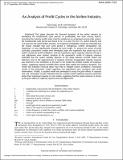An Analysis of Profit Cycles in the Airline Industry
Author(s)
Jiang, Helen; Hansman, R. John
DownloadAIAA-2006-7732-942 Profit Cycle.pdf (566.8Kb)
Metadata
Show full item recordAbstract
This paper discusses the financial dynamics of the airline industry by
identifying the fundamental cycle periods of profitability and their driving factors.
Assuming the industry profit cycles could be modeled as an undamped second-order system,
the fundamental cycle period was found to be 11.3 years for the U.S. airline industry and
10.5 years for the world airline industry. An empirical profitability model was estimated and
the results revealed that such cycle period is endogenous, neither deregulation nor
September 11 have significantly changed the cycle length. To analyze the causes of profit
cyclicality, parametric models were developed under the hypothesis that phase lag in the
system caused the profit oscillations; and two hypotheses, lag in capacity response and lag in
cost adjustment were studied. Analysis of the parametric model of capacity response
indicated that the system stability depends on the delay between aircraft orders and
deliveries and on the aggressiveness in airplane ordering. Exaggerated capacity response
was observed in the simulation as the gain in the model has lumped impacts of exogenous
factors, suggesting capacity shortfall alone cannot fully explain the industry dynamics. The
model also indicates reducing delay may help to mitigate system oscillations. Simulation
results of the parametric model regarding cost adjustment were consistent with profit
observations. Finally, a coupled model was developed to study the joint effects of capacity
and cost. Simulation results indicated that the coupled model explained industry dynamics
better than individual capacity or cost models, suggesting that the system behavior is driven
by the joint effects of capacity response and cost adjustment.
Date issued
2006-09-25Publisher
AIAA
Citation
6th AIAA Aviation Technology, Integration and Operations Conference (ATIO), 25 - 27 September 2006, Wichita, Kansas
Series/Report no.
AIAA 20067732
Keywords
Airline Management and Operations, financial dynamics